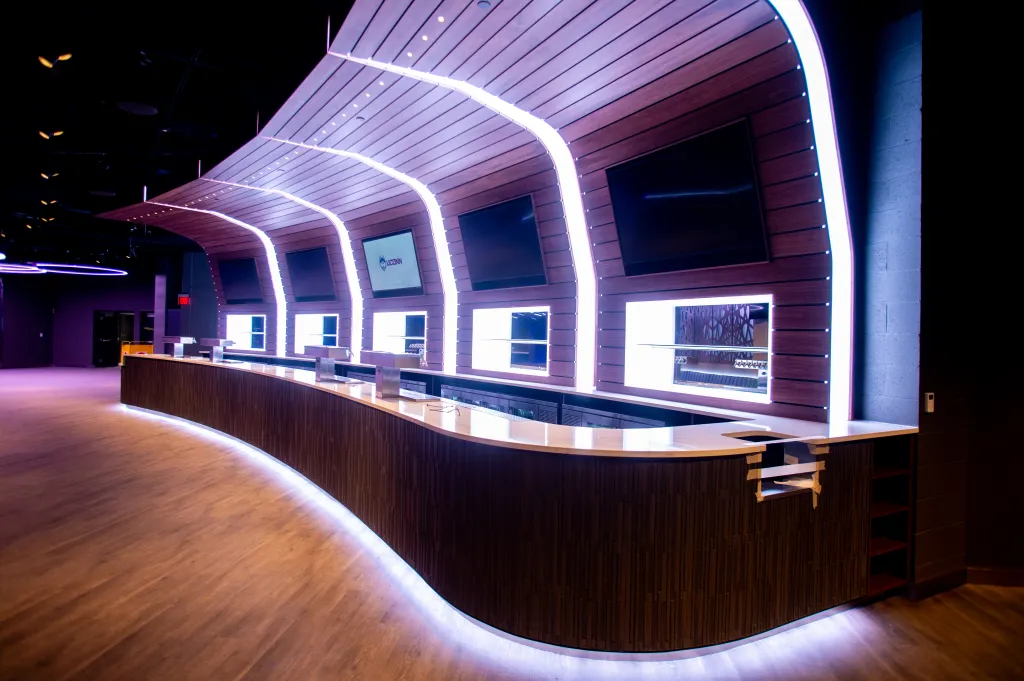
The bookings have already increased.
A decade ago, one study of downtown Hartford’s sports and entertainment arena found that a major renovation wouldn’t need the addition of more space — there was more than enough in the 16,000-seat venue — but the space just needed to be used in a dramatically different way.
And now, a long-debated, $145 million makeover of the 50-year-old, newly-christened PeoplesBank Arena has done just that, those leading the project say.
Event-level bunker suites have been carved out of space once occupied by the arena’s ice-making equipment. A glitzy club for premium ticket holders that can hold 700 has replaced storage areas and meeting rooms. And a 100,000-square-foot exhibition hall — basically rendered obsolete by the construction of Hartford’s convention center 20 years ago — is now the nerve center of the building’s mechanical systems and most storage.
“The very first analysis — they said, ‘Your building is bigger than most urban arenas, it’s just laid out poorly,’ ” Michael W. Freimuth, executive director of the Capital Region Development Authority, said, during a tour this week, especially the spaces that aren’t seen by the public.
Visitors will get their first chance to see the renovations when the former XL Center reopens Oct. 17 — after being closed since June — for the home opener of the AHL’s Wolf Pack.
But even sooner, outside the arena’s front entrance off Trumbull Street on Friday, there will be evidence of another change — this one in branding — with the expected unveiling of the new PeoplesBank Arena sign.
Oak View Group, which manages day-to-day operations at the arena and is a partner in the renovation project, said it is already seeing stepped up interest in potential concert bookings, even though the venue has not yet officially reopened.
Ben Weiss, OVG general manager for the arena, said concert bookings for the current fiscal year are on a pace to reach 15 or more, 30% more than the typical 7 to 10 concerts a year. OVG said it is possible to eventually reach 30 or more annually.
“We have a different story to tell,” Weiss said. “We have a great story to tell.”
The big-ticket renovation focused on the lower half or “bowl” of the arena.
A major thrust was moving patrons closer to the action with new premium spaces. These include five bunker suites, nearly 50 loge boxes with four to six, cushy armchairs; and the new club with its quartz bar countertops, aluminum paneling and cool, hip lighting.
Spaces such as these have become standard in modern arenas, as ticketholders want to both attend a sports match-up, concert or family-themed event, but also socialize at the same time. Premium spaces have perks such as the access to food and drink ordering and delivery services. CRDA, the quasi-public state agency that oversees the venue, hopes that also will relieve the long-time problem of congestion at concessions in the concourse.
Reversing annual losses
The strategy is to turn an aging arena into one that is more competitive to attract bookings and, at the same, introduce higher-priced premium seating. It is hoped those two factors together will reverse a long history of annual losses — typically $2 million a year shouldered by the state — and create a path to profitability.
The average annual cost of a bunker suite is $400,000, and $75,000 for a loge box. Weiss said those are being primarily marketed to businesses, which has shown interest. Club memberships, at $2,500 a seat annually, are being marketed to a broader audience of individuals and businesses, Weiss said.
Weiss said he couldn’t estimate what the one-time cost for the premium options because they would vary widely by type of event.
The arena will reopen in mid-October, but renovation work will continue until next summer on improvements but they will not interrupt arena operations. The bunker suites, for example, aren’t expected to be ready until November.
“Even though the focus was on the lower bowl, the whole place feels refreshed,” said David C. Robinson, chair of CRDA’s board of directors, who was on this week’s tour. “The concourse feels wider, less obstructed, which is terrific. And certainly the seating in the lower bowl — the fact that it’s now cushioned and comfortable, I think is a major improvement.”
There was not complete agreement in pushing forward on a makeover of the arena, and it was debated for years.
Critics argued against that investing $125 million of state taxpayer’s money in an arena that is now a half-century old is throwing good money after bad. They have also have questioned the extent of the economic ripple effect to bars, restaurants and hotels.
An initial $250 million vision was downsized to build support among state lawmakers, and the private investment — to lift some of the burden off taxpayers — was a critical requirement of Gov. Ned Lamont.
Supporters, who cheered the legislature’s decision to borrow the funds for the project, say the refurbished arena is essential to downtown prospering and will create a regional draw to the city.
‘Another 20 years or so’
CRDA’s partnership on the project with OVG, included the Denver-based organization contributing $20 million. OVG is considered to possess the depth of experience repositioning sports and entertainment venues. The organization manages 300 sports and entertainment venues globally and have redeveloped more than two dozen.
The renovation included the addition of more modern rigging systems that can handle the increasingly complex concert sound and lighting systems. An automated moveable section of seats for concerts will now allow the stage to be set farther back, which also required carving out a section of the arena.
The change increased the number of seats with views to the stage by 1,500 to about 13,000. That number, OVG has said, will make PeoplesBank Arena the largest concert venue in Connecticut with those views and make it competitive with arenas across North America.
As essential, Weiss said, is a new, dedicated, backstage suite of rooms for visiting artists that did not exist before. The suite includes dressing rooms, relaxing rooms and a party room for friends and visitors. The suite is located near the stage area, so the artist only has a short walk down a hallway.
Freimuth said it is a major upgrade from the “curtains and drapes” that were hung to create a space for performers.
The artist lounge is still under construction and won’t be ready for the Stevie Nicks concert on Oct. 25. But it will be completed by Dec. 12 when Andrea Bocelli performs at the arena. Weiss said.
Nicks, Weiss said, will use the space, already completed, for the University of Connecticut basketball and ice hockey teams that are also marquee tenants in the arena.
The UConn space is nearly triple the size of the locker room that it is replacing. The space includes a larger, circular locker room with wood-veneer paneled lockers and a video display board; a player lounge; equipment training areas, spaces reserved for the coaches; and a room for watching game day tapes, among other amenities.
At the conclusion of the tour, Freimuth said the last major renovation of the building that opened as the Hartford Civic Center was completed in 2014 at a cost of $35 million.
“We said it would ride us ten years,” Freimuth said. “This hopefully will stretch us another 20 years or so.”
Kenneth R. Gosselin can be reached at kgosselin@courant.com.



